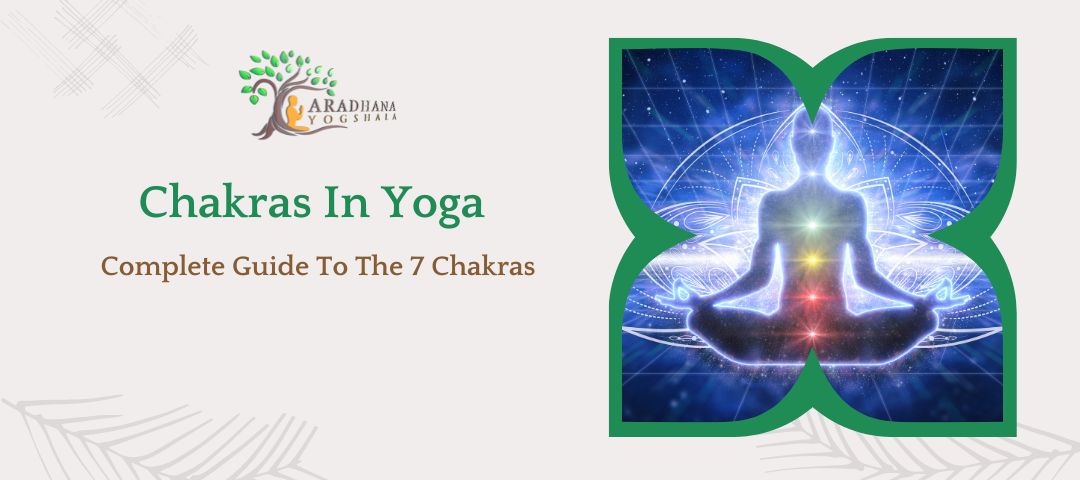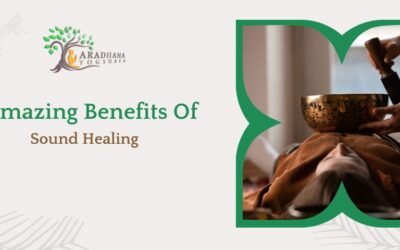Wouldn’t it be great to shed our problems outside just like we leave our shoes at the door when we enter a yoga studio? Yoga experts believe that yoga poses and breathing exercises help generate a special energy called “prana,” or life force in our bodies. This energy flows through seven energy centers in our body called “chakras,” helping us feel balanced and relaxed.
In the world of yoga and spiritual wellness, the concept of body chakras holds a significant place. These energy centers are vital to understanding the holistic nature of yoga practice and how it can positively impact your physical, mental, and emotional well-being. So, to help you understand the concept of chakras in the body, Aradhana Yogashala has drafted this blog. Here, our qualified yoga teachers in Rishikesh have listed the seven chakras, their significance, and practical ways to balance and align them for a harmonious life.
What Are Chakras In Yoga?
Body Chakras are energy centers that are often associated with yoga, particularly in various forms of Hinduism and Buddhism. The word “chakra” comes from Sanskrit, meaning “wheel” or “circle.” These energy centers are believed to be located along the spine, from the base to the crown of the head, and are said to play a vital role in a person’s physical, mental, and spiritual well-being.
There are mainly 7 chakras in yoga, each associated with specific qualities, colors, and aspects of human experience:
- Root Chakra (Muladhara)
- Sacral Chakra (Svadhisthana
- Solar Plexus Chakra (Manipura
- Heart Chakra (Anahata)
- Throat Chakra (Vishuddha)
- Third Eye Chakra (Ajna)
- Crown Chakra (Sahasrara)
7 Body Chakras And Their Balancing Techniques
The seven chakras are energy centers that are believed to exist within our subtle body, aligning along the spine from its base to the crown of the head. Each chakra is associated with specific physical, emotional, and spiritual attributes. Balancing and harmonizing these chakras promotes overall well-being and personal growth.
1. Root Chakra (Muladhara)
- Location: Located at the base of the spine.
- Color: Red.
- Element: Earth.
The Root Chakra represents our foundation and connection to the physical world. It’s associated with survival, security, and stability. Imbalances in this chakra can manifest as anxiety, fear, financial troubles, or physical issues in the legs, feet, or lower back. Yoga poses like the Child’s Pose, and natural grounding practices can help balance the Root Chakra.
2. Sacral Chakra (Svadhisthana)
- Location: Just below the navel, in the lower abdomen.
- Color: Orange.
- Element: Water.
The Sacral Chakra is associated with emotions, creativity, and sensuality. It governs our ability to enjoy life, connect with others, and experience pleasure. An imbalance in this yoga chakra can manifest as emotional instability or creative blocks. Yoga poses that involve hip movements and meditation on the element of water can help align this chakra.
3. Solar Plexus Chakra (Manipura)
- Location: In the upper abdomen, just below the ribcage.
- Color: Yellow.
- Element: Fire.
The Solar Plexus Chakra relates to personal power, self-esteem, and confidence. It’s associated with our ability to make decisions and maintain ourselves. Low self-esteem, feelings of powerlessness, or digestive issues can be signs of an imbalanced Solar Plexus Chakra. Core-strengthening yoga poses, self-empowerment exercises, and wearing yellow clothing or accessories can help balance this chakra in the body.
4. Heart Chakra (Anahata)
- Location: In the center of the chest, near the heart.
- Color: Green (sometimes pink).
- Element: Air.
The Heart Chakra is the center of love, compassion, and forgiveness. A balanced Heart Chakra fosters love for oneself and others, while an imbalance may result in heartache or emotional detachment. Difficulty in forming connections, excessive self-sacrifice, or heart-related health issues may indicate an imbalance in the Anahata Chakra. This can be balanced by heart-opening yoga poses, heart-centered meditations, and acts of kindness.
5. Throat Chakra (Vishuddha)
- Location: At the throat.
- Color: Blue.
- Element: Ether (or space).
The Throat Chakra is connected to communication, self-expression, and truth. It governs our ability to express ourselves authentically.
A balanced Throat Chakra promotes effective communication, while an imbalance can lead to difficulty expressing oneself or fear of judgment. Throat-related ailments may also suggest an imbalance in this yoga chakra. This balance can be restored by practicing yoga poses that stretch the neck and throat, along with affirmations.
6. Third Eye Chakra (Ajna)
- Location: In the middle of the forehead, slightly above and between the eyebrows.
- Color: Indigo (deep blue).
- Element: Light.
The Third Eye Chakra is associated with intuition, insight, and spiritual awareness. It controls our ability to see the bigger picture and trust our inner guidance. A balanced Third Eye Chakra enhances intuition and inner guidance, while an imbalance may result in confusion or a lack of clarity. Meditation, mindfulness, and deepening your spiritual practice can help balance the Third Eye Chakra.
7. Crown Chakra (Sahasrara)
- Location: At the crown of the head.
- Color: Violet (or white/gold).
- Element: Thought or pure consciousness.
The Crown Chakra represents our connection to universal consciousness, spirituality, and enlightenment. It is the highest chakra in the body and symbolizes our highest potential. Disconnection from spirituality, a sense of purposelessness, or confusion about life’s meaning may suggest an imbalance. The Crown Chakra can be balanced by Meditation, spiritual exploration, and seeking higher knowledge.
Conclusion
Balancing and aligning these chakras in yoga is a holistic journey toward physical health, emotional harmony, and spiritual growth. Yoga and meditation practitioners often incorporate Chakra balancing techniques and practices tailored to each chakra to boost overall well-being and self-realization.
Hope this guide has provided an introductory understanding of the seven chakras, but achieving the optimal balance for your distinct physical, emotional, and spiritual well-being involves deeper exploration and practices. To delve further into this subject, you can enhance your knowledge by enrolling yourself in the various yoga teacher training courses in Rishikesh offered by Aradhana Yogashala. There, you can access a complimentary masterclass led by our qualified yoga teachers.
So, why wait to power up your body chakras? Give a missed call at +91-95575 91290 today, or you can mail your enrollment request to info@aradhanayogashala.com.
Related Blogs
9 Amazing Benefits Of Sound Healing
Are you aware that sound has the power to promote healing? Indeed, it's a reality! If you're in search of a method to relax and shed stress, sound healing might just be the solution you've been seeking. Sound healing is experiencing a rebirth in popularity. It is an...
Sound Healing: Harmonizing Your Mind, Body, And Soul For Optimal Well-Being
In today's fast-paced and stressful world, people constantly seek effective ways to promote their physical, mental, and emotional well-being. One technique that has gained significant attention in recent years is sound healing. Rooted in ancient practices and...
International Yoga Day: Experience The Best At Rishikesh’s Top Yoga School
International Yoga Day, celebrated on June 21st every year, is a global event highlighting yoga's importance in promoting holistic health and overall well-being. This day serves as a reminder of the transformative power of yoga and its ability to unite people from all...




